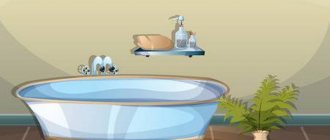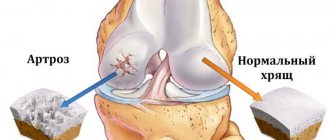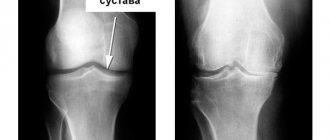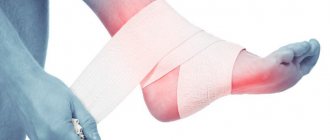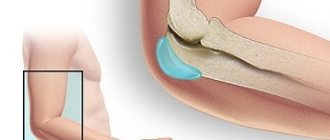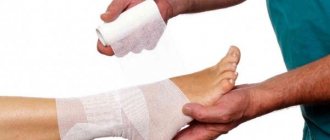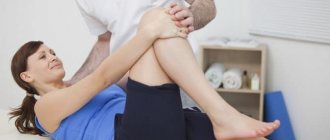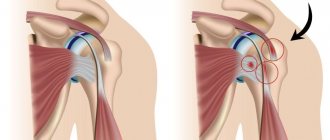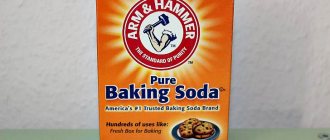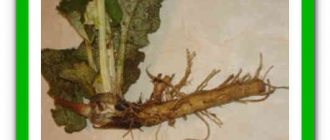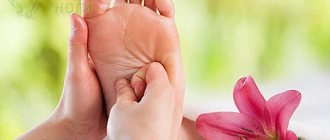Arthrosis of the ankle joint is a fairly common disease and is most often chronic, which means it cannot be completely cured. It progresses gradually, and in order to achieve improvement, it is necessary to select an individual set of measures, not only medications, but also folk ones. We will tell you in more detail about what arthrosis of the ankle joint is, what its symptoms are and how treatment is carried out at home.
Healthy and damaged joint
Symptoms of ankle arthrosis
Arthrosis of the ankle is the destruction of cartilage tissue. Signs of the disease and its typical symptoms do not appear immediately. At first, the patient feels some pain in the ankle area only in the morning, in the first hours after waking up. After some time, painful sensations are suppressed as the body begins to produce active painkillers. That is why during this period of illness few people turn to a doctor for help. Gradually the symptoms intensify:
- Severe pain does not go away, and sometimes, on the contrary, intensifies throughout the day;
- The foot swells greatly, it is difficult for the patient to wear usual shoes;
- When walking or other movements of the ankle, crunching sounds are heard;
- At night, the pain is aggravated by cramps;
- The patient's gait changes because the habitual step increases the pain.
Symptoms of ankle arthrosis appear gradually.
The risk of injury, dislocation, bruise and fracture increases, the treatment of which is already complicated by pathological processes in the joint.
Doctors identify excess weight, weightlifting, injuries, improper footwear and certain diseases, including cardiovascular diseases, as the main causes of symptoms. The risk of arthrosis increases with age and ultimately almost every person falls into the risk group.
Diagnostics
Since the symptoms of the disease are not always pronounced, and some signs are typical for other joint diseases, it is important to correctly diagnose arthrosis. Diagnostics is carried out in 2 stages. At the first stage, the doctor prescribes the necessary tests, the results of which make it clear whether degenerative changes in the joint have really begun. Then the second stage begins, namely determining the current stage of the disease. Here, X-ray diagnostics, CT, and MRI come to the rescue, allowing you to see how thin the cartilage tissue is and what condition the joints are in.
MRI image
Based on the results of the examination, a set of measures is selected that can stop destructive processes and relieve painful symptoms. As a rule, treatment is carried out at home and the patient does not need a hospital stay. Only severely advanced disease requires surgical intervention.
Traditional treatment at home
There are quite a few ways to treat foot arthrosis at home.
Classic medicinal, folk, and physiotherapeutic methods are used. sometimes the doctor decides to combine several techniques to achieve the most effective result.
Drug treatment
The need to use medications is due to severe pain and inflammation developing in the ankle. To relieve them, non-steroidal anti-inflammatory painkillers are prescribed. They are used for both indoor and outdoor use.
Pills
The main symptom that affects the patient’s lifestyle and condition is pain. It does not allow you to stand on the sole, so treatment of arthrosis of the feet at home begins with pain relief with tablets. Such drugs as ibuprofen, ketoprofen, nimesulide have proven themselves well. Sometimes instead of NSAIDs, doctors prescribe analgesics: spasmalgon, analgin, viprosal.
Medicines should be taken only after a doctor’s prescription and in the indicated dosage. The period of use of tablets is strictly limited, as they can be addictive. In addition, the doctor must be aware of the presence of concomitant diseases, since some drugs have side effects.
Ointments
For external use, a large number of medicinal ointments are used, with which the treatment of joints becomes more effective. They enhance the anti-inflammatory and analgesic effect of the tablets. It is often recommended to use Voltaren, Fastum-gel, Menovazin, Diclofenac and others. The advantage of ointments is that they do not have a serious effect on internal organs and can be used longer.
Gymnastics for feet
Drug treatment may not be enough to restore normal physical activity. Another available method for relieving painful symptoms is special gymnastics for the feet. It helps speed up recovery processes, reduces pain, and ensures joint rehabilitation.
When performing gymnastics, it is important to follow the basic rules:
- It should be systematic, at least 2 times a day and for at least 10 minutes;
- In the first days, preference is given to a simple exercise, gradually the degree of complexity increases;
- It is important to do the exercises slowly, while monitoring your breathing;
- It is not recommended to start gymnastics until the pain is relieved.
It is better to coordinate a set of exercises with the attending physician who is familiar with the patient’s health characteristics, his medical history and current condition.
Diet for arthrosis
Due to the nature of the disease, doctors recommend additional diet during treatment. To restore cartilage tissue, it is extremely important to obtain the necessary nutrients, vitamins and minerals. All nutrition should be aimed at saturating the body of the person treating the feet with vitamins B, C, unsaturated fatty acids, calcium, and protein. They improve the elasticity of cartilage tissue, preventing its further destruction. You will have to completely eliminate or at least minimize the use of:
- Fatty meats.
- Confectionery products.
- Fast food.
- Sparkling water.
- Spices, sauces.
- Smoked meats.
The patient’s diet should be healthy.
The patient’s menu should include daily:
| Poultry meat | Chicken, turkey |
| Fatty fish | Herring, salmon, sardine, mackerel |
| Natural dairy products | Skim milk, yogurt, cheese |
| Nuts | Almonds, pine nuts, hazelnuts |
| Cereals rich in carbohydrates | Brown rice |
| Fruits and vegetables | Pomegranate, pineapple, avocado, apple |
| Legumes | Soybeans, peas, beans, lentils |
| Eggs | Chicken |
Meals should be frequent, but in small portions, and all dishes should be fresh. It is better to choose boiling or stewing as a cooking method.
Physiotherapy at home
Physiotherapy therapy is prescribed to almost all patients suffering from arthrosis. There are only some contraindications to the use of this treatment method. Among them:
- Pregnancy and lactation period.
- Severe blood diseases, heart diseases, cancer.
- Lesions of the central nervous system, including epilepsy.
- Purulent skin rashes.
If the patient has a history of any of these problems, he should refuse to undergo any physical therapy procedures.
Carrying out a physiotherapeutic procedure
Only certain types of physiotherapy can be performed at home: magnetic, electrophoresis, paraffin therapy. In this case, you will have to acquire special devices or other means.
The number of procedures and their duration should always be determined by the doctor. If all the rules for using devices are followed, physical therapy can help reduce the number of medications taken.
Massage
Ankle massage can be helpful as an adjunct to physical therapy. It has a good effect on the nervous and muscle tissue of the foot, improves blood circulation. At home, massage is performed using medicinal oils. The session itself lasts no more than 25 minutes. During this time, the massage therapist, moving from the toes up the leg, manages to work not only with the part of the foot affected by arthrosis, but also with the area nearby. The course lasts 10-14 days, and it is advisable to conduct it by a specialist familiar with the structural features of the leg.
Massage for this disease improves blood circulation
What can be used
Infusions and decoctions of medicinal plants for internal use have proven themselves well in the treatment of osteoarthritis. They have a tonic effect on the entire body, remove harmful substances from it, and serve as a source of bioflavonoids, organic acids, phytoncides, fat- and water-soluble vitamins.
Among external remedies, preference should be given to those approved by official medicine. These are compresses with clay, applications with ozokerite, paraffin, bischofite. To prevent painful relapses, you can use compresses with vodka or alcohol and abandon them if the pathology worsens.
Homemade ointments should contain components that have a therapeutic effect specifically for diseases of the musculoskeletal system. These are essential oils obtained from coniferous trees and shrubs (juniper, fir, spruce, pine), gum turpentine, camphor oil.
Traditional methods
Treatment of ankle arthrosis at home with medications does not exclude the additional use of traditional methods. All kinds of decoctions and tinctures made from natural remedies can be used for both external and internal use.
Systemic treatment
Systemic treatment assumes that the effect is on the entire body, and not just on the affected ankle joints. As a result, the body becomes stronger, metabolic processes improve, and healing processes proceed faster. Such a broad effect can be achieved through the internal use of products made according to folk recipes.
Decoctions and infusions
There are quite a lot of herbs that can have a positive effect during the treatment of arthrosis. To relieve pain and simultaneously renew tissue, you can make tinctures from St. John's wort, birch leaves, and nettle. Metabolism will be improved by nettle, calendula, willow bark, and birch leaves.
Decoctions and infusions are widely used for treatment
To increase joint mobility, you can make a cinquefoil tincture with alcohol or vodka. To do this, cinquefoil roots are crushed, placed in a liter jar and filled with alcohol or vodka. In this case, the grass should occupy a third of the jar. The resulting mass is infused for 3 weeks in a dark place, and then consumed three times a day, a tablespoon before meals.
Juices
Saturation of the body with vitamins, as well as the removal of harmful toxins and salts, is possible by consuming natural freshly squeezed juices. For arthrosis, juices from:
- Cabbages.
- Carrots.
- Cucumber.
- Beetroot.
- Watermelon.
- Strawberries.
- Lemon.
- Grapes.
- Cherries.
- Lingonberries.
Fresh juices from vegetables and fruits will bring great benefits to the body.
They can be mixed or taken separately. The course of treatment is 10 days, during which you need to drink a glass of the drink.
Local treatment
Local treatment with folk remedies can also be effective. When treating ankle arthrosis, baths, compresses, rubbing, wraps, as well as homemade ointments from different types of plants are used.
Foot baths
Therapeutic baths based on turpentine, iodine, sea salt or medicinal mud will provide good help to a sore foot at home. They improve vascular circulation and metabolism, which in turn provides additional nutrition to the joints. Due to the structure of the ankle, foot baths affect the body faster than products designed for internal use. Sessions can be performed every 3 days for a month. Your feet should stay in this bath for about 20 minutes.
Salt baths can be made using sea or regular salt. In the first case, 3 small spoons of salt per basin filled with water is enough, in the second - 3 tablespoons. Additionally, you can add the juice of two lemons to the bath.
Compresses
Arthrosis of the ankle can be treated with compresses. They are made on the basis of:
- Propolis;
- Salts;
- Dandelion;
- Kefir;
- Cabbage leaf;
- Horseradish roots.
Using a salt compress
They contain large quantities of vitamin C and other beneficial substances. The method of preparing such medicines is very simple. For example, to make anti-inflammatory compresses from horseradish root, you need to chop it, place it in water and bring it to a boil. The resulting mass is placed on a cloth and applied to the ankle. Other compresses are made in a similar way.
Rubbing
Using ointments and rubbing, the ankle joint is warmed, which stimulates blood flow and reduces pain. Rubs are made from potatoes, garlic, mustard, and iodine. The ground ingredients are mixed with oil, and the resulting product is rubbed into the skin of the ankle in a circular motion. The product should be used daily, 2-3 times a day for a couple of weeks.
A potato and horseradish based rub is prepared according to a very simple recipe. 300 grams of raw potatoes and horseradish root are grated. A tablespoon of honey is added to the resulting mass. The finished rub is applied to the affected part of the leg in a good layer and left for at least an hour.
Wraps
Another method used to cure foot arthrosis at home is therapeutic wraps. They are effective while the disease is in its early stages of development. They should be done after consulting a doctor, since the risk of developing allergies is high.
Wrapping is an effective procedure in the initial stages of the disease
Mud wraps, which can be purchased at any pharmacy or collected independently from peat in swamps, have proven themselves well. The collected mass is thoroughly dried for storage. Before use, the dry mixture is mixed with water in a ratio of 1 to 7, and then applied to the ankle.
Tinctures and ointments
Homemade tinctures and ointments can be a good alternative to pharmaceutical drugs. For the treatment of arthrosis, a mixture of nettle leaves and juniper berries helps well. The crushed mixture is mixed with petroleum jelly or alcohol, and then the medicine is infused in the dark for several days. When the ointment or tincture is ready, it is applied to the affected part of the ankle, which has a warming effect. Sometimes juniper and nettle are replaced with horseradish leaves.
Basic principles of treatment with folk remedies
Clinical manifestations of the pathology include stiffness of the ankle joint, its morning swelling and stiffness of movement. In official medicine, at this stage of osteoarthritis, the use of ointments with NSAIDs is practiced. But, despite their external use, in some cases they provoke the development of local and systemic adverse reactions. Remedies made according to recipes from traditional healers have virtually no toxic effects on the body and have many positive properties:
- eliminate swelling of soft tissues that occurs when they are damaged by bone growths;
- remove waste, toxins, and tissue breakdown products from the ankle joint;
- improve trophism in the joints by eliminating the deficiency of nutrients, vitamins and microelements;
- stimulate the regeneration of soft tissues and connective tissue structures;
- normalize microcirculation, increase the production of synovial fluid.
Treatment of osteoarthritis of the ankle joint with folk remedies is carried out only when stable remission is achieved. At this stage, the patient experiences aching, nagging pain during a sudden change in weather, hypothermia, or after intense physical activity.
Swelling may appear after exercise.
